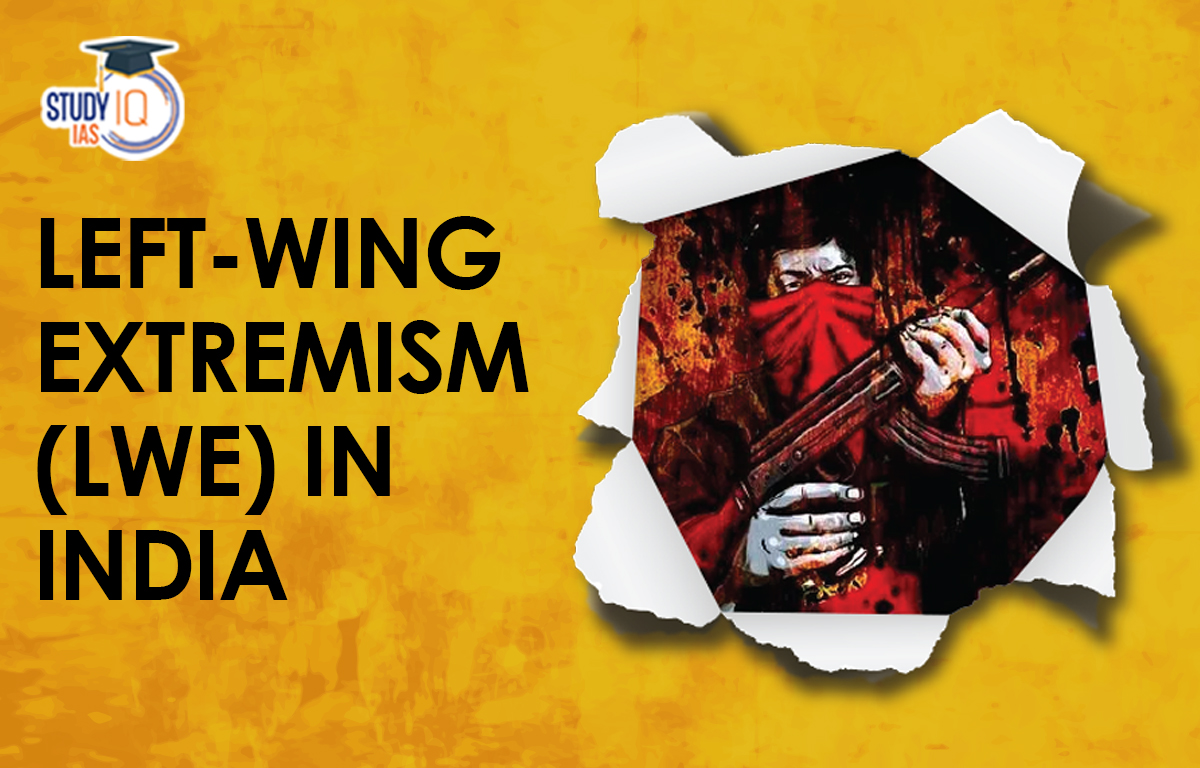Table of Contents
Context: The recent improvised explosive device (IED) attack by Maoists in Chhattisgarh’s Bastar killed ten District Reserve Guard (DRG) personnel.
What is Left Wing Extremism?
- Left Wing Extremism is an umbrella term referring to violence committed by extremist groups that follow the ideology that the solution to social and economic discrimination is to overthrow the existing political system.
- Their ideology is based on the belief of the Chinese political leader Mao Zedong.
- Evolution of LWE in India:
- The LWE movement originated in West Bengal’s Naxalbari in 1967. It is also known as Naxal movement or Maoists movement.
- The initial revolt was in form of a peasant revolt against local zamindars. It was led by Charu Majumdar, Kanu Sanyal and Jangal Santhal, who were members of the Communist Party of India (Marxist).
- The Communist Party of India (Marxist–Leninist) was formed in 1969. The movement later spread to states such as Telangana, Andhra Pradesh, Odisha and Chhattisgarh.

Reasons for the Rise of LWE
- Historical injustice: Tribals have faced historical injustices from landlords as well as successive governments. This created anti-establishment sentiments among them, leading to modern-day LWE.
- Displacement of locals: Projects such as mining and industries in tribal areas led to widespread displacement of locals. The fear of losing their lands was misused by LWE leaders to derive support from tribals.
- Inaccessibility: LWE areas are located in thick forests and mountainous regions that are not properly accessible. This acted as an impediment for security forces in policing these areas.
- Lack of development: LWE areas are historically under-developed. They do not have proper connectivity and their residents are deprived of schools, hospitals and other important infrastructure. This created anti-establishment sentiments among the locals.
- Marginalization of tribals: The settling of outsiders in tribal areas led to marginalization of locals. The fear of displacement prompted local tribals to support LWE movement.
- Gaps in local administration: In many states, the local government did not take concrete steps to overcome extremism; instead they passed the onus on the central government.
- This lack of coordination gave time for the movement to sustain and become as a major internal security challenge for the country.
Threats posed by LWE
- Disrupt democratic process: Naxals prevent locals from contesting elections or vote. They try to create negative opinions about participatory democracy.
- Disrupting law and order: Naxals are involved in kidnapping, killing as well as destroying roads and buildings. This creates a bad law and order situation in the area.
- Rebellion against elected government: Naxalites promote uneducated tribals to pick arms and rebel against elected governments. This is a serious threat to internal security.
- Alienate tribals: Activities of Naxals further alienate the tribals from mainstream. This strengthens anti-establishment sentiments.
- Smuggling arms and narcotics: LWE cadres are involved in smuggling of arms and narcotics to fund their activities.
Tackling LWE
- Strengthening police force: The extremists have access to sophisticated weapons and technology. The police force should be equally equipped in order for them to successfully defeat LWE.
- Integration of locals: Hard approach must be complemented with a soft approach, which involves integration of locals into the mainstream.
- They must be made to feel that the government and administration belongs to them. Their concerns must be properly addressed.
- Creation of infrastructure: Infrastructure in form of roads, bridges, schools, hospitals, banks, administrative offices will all act as fuel for development. This can neutralize anti-establishment sentiments prevalent among locals.
- Providing traditional rights: Government has taken measures such as giving them access to forest produce and traditional tilling rights. This has helped contain dissent up to certain extent.
- Financial deprivation: Extremists raise finances mainly through extortion and illegal activities. By reducing such incidents, the movement can be overcome.

Stats IQ: Current Trends
- The Naxal violence in India has decreased by 77 per cent over the past 12 years and the number of deaths in related incidents has also reduced by 90 per cent during the same period, the government said in Lok Sabha.
- There has been a decline in geographical spread of violence is also reflected in the reduced number of districts covered under the security related expenditure (SRE) scheme.
- 126 districts were covered under the SRE scheme in 2010 but that number came down to 90 in April 2018 and further to 70 in July 2021.
Government measures to tackle LWE
- SAMADHAN doctrine: It is an amalgamation of eight short-term to long-term policies formulated at different levels.
- S- Smart Leadership
- A- Aggressive Strategy
- M- Motivation and Training
- A- Actionable Intelligence
- D- Dashboard Based KPIs (Key Performance Indicators) and KRAs (Key Result Areas)
- H- Harnessing Technology
- A- Action plan for each Theatre
- N- No access to Financing
- Panchayat Extension to Scheduled Areas (PESA): PESA Act gave self-rule for people living in scheduled areas of India. The gram Sabha was given more power concerning local issues, including land acquisition, mining, access to resources etc.
- Forest Rights Act, 2006: The FRA gave title rights, producer rights, and developmental rights so that their livelihoods are protected.
- The Gram Sabha has been given the authority to initiate the process for determining the nature and extent of Individual Forest Rights (IFR) or Community Forest Rights (CFR).
- National Policy and Action Plan in 2015: It consists of a multi-pronged approach that includes security measures, development initiatives and ensuring rights & entitlements of local communities.
- Funds are provided to state governments under Modernization of Police Force (MPF), Security Related Expenditure (SRE) Scheme and Special Infrastructure Scheme (SIS) for modernization and training of State Police.
- Special Central Assistance (SCA) scheme: This scheme has been able to fill critical gaps in public infrastructure and services. Projects such as road repair, improvement in health infrastructure, education related projects, rural infrastructure projects etc. have been undertaken under this scheme.
- Eklavya Model Residential Schools (EMRSs): EMRS is a scheme that aims to develop model residential schools for students belonging to Scheduled Tribes. These schools will not only provide them with quality education but also promote all round development.
Counter-Insurgencies across LWE areas
- Salwa Judum: Salwa Judum (peace force) was launched by villagers angered by Naxal interference in the local trade of tendu leaves.
- It recruited local tribals and former Naxalites and made them Special Police Officers (SPOs).
- Grey Hounds: It is the elite commando force of combined Andhra Pradesh state, created to fight left-wing extremists. It is considered the best anti-Naxalite force in the country.
- It follows the guerrilla approach, which is near similar to that of the Maoists, making them effective.
- Operation Green Hunt: It was an unofficial term used to describe the “all-out offensive” launched by the government of India’s paramilitary forces and the state’s forces to defeat the Naxalites.
Way Forward
- A one-dimensional approach, focusing excessively on security aspects, is not enough o effectively tackle LWE in India.
- There has to be an empathetic approach to address the conditions of the poor and the tribals so that their dissent is checked and not diverted into a movement such as this.
- Creation of road and rail infrastructure will not just enhance economic growth and development but will also help in countering Maoist propaganda against the state.


 Chakma and Hajong Communities: History, ...
Chakma and Hajong Communities: History, ...
 Commission for Air Quality Management (C...
Commission for Air Quality Management (C...
 Gujarat Bridge Collapse: 9 Dead as Gambh...
Gujarat Bridge Collapse: 9 Dead as Gambh...





















